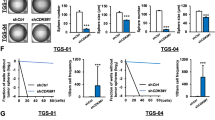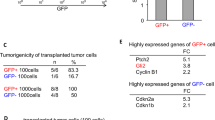Abstract
A selective switch from expression of Shc1 gene to Shc3 occurs with maturation of neuronal precursors into postmitotic neurons. Previous studies showed that in the embryo, Shc1 is maximally expressed in dividing CNS stem cells while it is silenced in mature neurons, where it is replaced by Shc3. Under normal conditions Shc3 is never expressed by glial cells. We now show that in human astrocytomas and glioblastomas, the normal pattern of expression of Shc1/Shc3 is totally subverted, both proteins being present at the same time and in the same cells. Our data indicate that Shc3 is maximally expressed, together with Shc1, in glioblastoma, a highly proliferative tumor with little, if any, indication of neuronal differentiation. In primary cultures of glioblastoma, tumor cells maintain Shc1 expression but downregulate Shc3. Analysis of the phosphorylation status of Shc3 in human glioblastoma tumor samples in vivo indicates that it is tyrosine phosphorylated. Finally, we found that the expression of truncated variants of Shc3 with dominant-negative effects in human high-grade glioma cells that maintain Shc3 expression in vitro leads to a decreased Akt posphorylation and increased apoptosis, thus resulting in impaired survival of the transfected cells. These data suggest that Shc molecules play an important role in glioblastoma cell growth and survival.
This is a preview of subscription content, access via your institution
Access options
Subscribe to this journal
Receive 50 print issues and online access
$259.00 per year
only $5.18 per issue
Buy this article
- Purchase on Springer Link
- Instant access to full article PDF
Prices may be subject to local taxes which are calculated during checkout








Similar content being viewed by others
References
Airaksinen MS and Saarma M . (2002). Nat. Rev. Neurosci., 3, 383–394.
Cattaneo E, Magrassi L, De-Fraja C, Conti L, Di Gennaro I, Butti G and Govoni S . (1998). Anticancer Res., 18, 2381–2387.
Cattaneo E and Pelicci PG . (1998). Trends Neurosci., 21, 476–481.
Conti L, Sipione S, Magrassi L, Bonfanti L, Rigamonti D, Pettirossi V, Peschanski M, Haddad B, Pelicci P, Milanesi G, Pelicci G and Cattaneo E . (2001). Nat. Neurosci., 4, 579–586.
Dirks WG, Fahnrich S, Lis Y, Becker E, MacLeod RA and Drexler HG . (2002). Int. J. Cancer, 100, 49–56.
Fujimoto J, Shiota M, Iwahara T, Seki N, Satoh H, Mori S and Yamamoto T . (1996). Proc. Natl. Acad. Sci. USA, 93, 4181–4186.
Guha A, Feldkamp MM, Lau N, Boss G and Pawson A . (1997). Oncogene, 15, 2755–2765.
Hecker TP, Ding Q, Rege TA, Hanks SK and Gladson CL . (2004). Oncogene, 23, 3962–3971.
Hecker TP, Grammer JR, Gillespie GY, Stewart J and Gladson CL . (2002). Cancer Res., 62, 2699–2707.
Lemkine GF, Goula D, Becker N, Paleari L, Levi G and Demeneix BA . (1999). J. Drug Target, 7, 305–312.
Li J, Yen C, Liaw D, Podsypanina K, Bose S, Wang SI, Puc J, Miliaresis C, Rodgers L, McCombie R, Bigner SH, Giovanella BC, Ittmann M, Tycko B, Hibshoosh H, Wigler MH and Parsons R . (1997). Science, 275, 1943–1947.
Miyake I, Hakomori Y, Shinohara A, Gamou T, Saito M, Iwamatsu A and Sakai R . (2002). Oncogene, 21, 5823–5834.
Mossmann T . (1983). J. Immunol. Methods, 65, 55–63.
Nikkhah G, Tonn JC, Hoffmann O, Kraemer HP, Darling JL, Schonmayr R and Schachenmayr W . (1992). J. Neurooncol., 13, 1–11.
Nishiguchi M, Tokugawa K, Yamamoto K, Akama T, Nozawa Y, Chaki S, Ueki T, Kameo K and Okuyama S . (2003). Neurochem. Int., 42, 493–498.
O’Bryan JP, Lambert QT and Der CJ . (1998). J. Biol. Chem., 273, 20431–20437.
Pandita A, Aldape KD, Zadeh G, Guha A and James CD . (2004). Genes Chromosomes Cancer, 39, 29–36.
Pelicci G, Troglio F, Bodini A, Melillo RM, Pettirossi V, Coda L, De Giuseppe A, Santoro M and Pelicci PG . (2002). Mol. Cell. Biol., 22, 7351–7363.
Pore N, Liu S, Haas-Kogan DA, O’Rourke DM and Maity A . (2003). Cancer Res., 63, 236–241.
Powers C, Aigner A, Stoica GE, McDonnell K and Wellstein A . (2002). J. Biol. Chem., 277, 14153–14158.
Prigent SA, Nagane M, Lin H, Huvar I, Boss GR, Feramisco JR, Cavenee WK and Huang HS . (1996). J. Biol. Chem., 271, 25639–25645.
Rebbaa A, Yamamoto H, Saito T, Meuillet E, Kim P, Kersey DS, Bremer EG, Taniguchi N and Moskal JR . (1997). J. Biol. Chem., 272, 9275–9279.
Rubenstein M, Glick R, Lichtor T, Mirochnik Y, Chou P and Guinan P . (2001). Med. Oncol., 18, 121–130.
Russo C, Dolcini V, Salis S, Venezia V, Zambrano N, Russo T and Schettini G . (2002). J. Biol. Chem., 277, 35282–35288.
Stoica GE, Kuo A, Aigner A, Sunitha I, Souttou B, Malerczyk C, Caughey DJ, Wen D, Karavanov A, Riegel AT and Wellstein A . (2001). J. Biol. Chem., 276, 16772–16779.
Su JD, Mayo LD, Donner DB and Durden DL . (2003). Cancer Res., 63, 3585–3592.
Trinei M, Lanfrancone L, Campo E, Pulford K, Mason DY, Pelicci PG and Falini B . (2000). Cancer Res., 60, 793–798.
Trupp M, Scott R, Whittemore SR and Ibanez CF . (1999). J. Biol. Chem., 274, 20885–20894.
Wiesenhofer B, Stockhammer G, Kostron H, Maier H, Hinterhuber H and Humpel C . (2000). Acta Neuropathol. (Berl), 99, 131–137.
Acknowledgements
We thank Professor G Milanesi for his hospitality and continuous support, Dr M Ferrari (Centro substrati cellulari, Istituto Zooprofilattico Sperimentale della Lombardia e dell’Emilia) for her generous gift of U87MG, U254, U373MG, T98G, CCF-STTG1, SW1088, cell lines and Dr Comicini (Dipartimento di Genetica e Microbiologia Università di Pavia) for his generous gift of the D384 cell line. This work was supported by grants from M.U.R.S.T. (FIRB 2001, Italy; #RBNE01-08) to LM and M.U.R.S.T. (FIRB 2001, Italy; #RBNE01-01) and Associazione Italiana Ricerca sul Cancro (AIRC, Italy) to EC. We thank P delli Santi and I Marini for their excellent technical support.
Author information
Authors and Affiliations
Corresponding author
Rights and permissions
About this article
Cite this article
Magrassi, L., Conti, L., Lanterna, A. et al. Shc3 affects human high-grade astrocytomas survival. Oncogene 24, 5198–5206 (2005). https://doi.org/10.1038/sj.onc.1208708
Received:
Revised:
Accepted:
Published:
Issue Date:
DOI: https://doi.org/10.1038/sj.onc.1208708
Keywords
This article is cited by
-
Phosphorylation of RasGRP1 by Shc3 prevents RasGRP1 degradation and contributes to Ras/c-Jun activation in hepatocellular carcinoma
Molecular and Cellular Biochemistry (2023)
-
Shc3 promotes hepatocellular carcinoma stemness and drug resistance by interacting with β-catenin to inhibit its ubiquitin degradation pathway
Cell Death & Disease (2021)
-
Distinct role of ShcC docking protein in the differentiation of neuroblastoma
Oncogene (2009)



